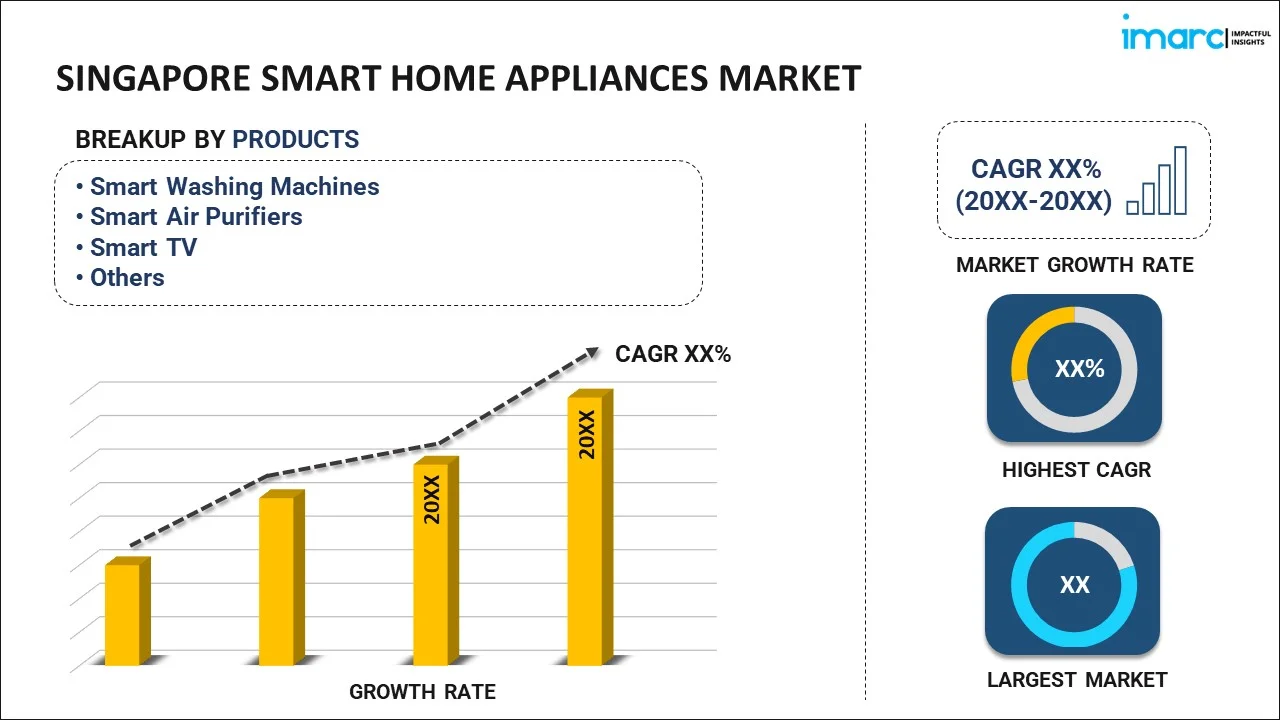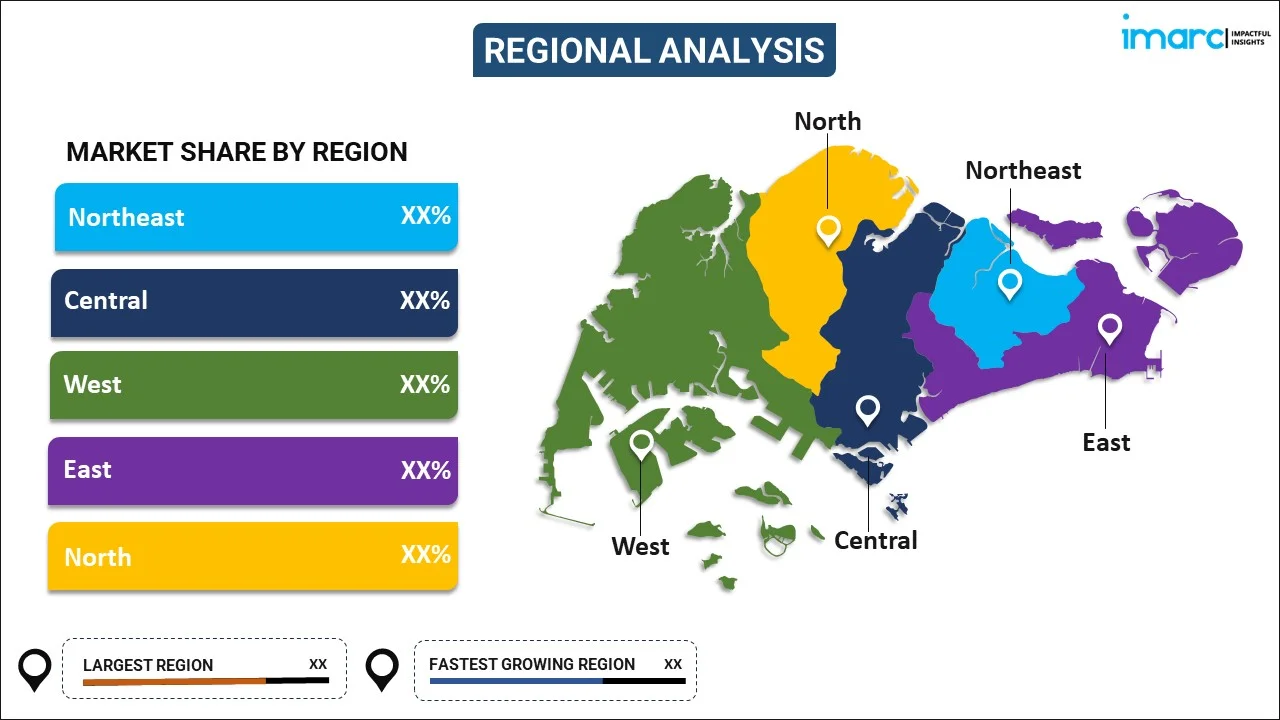
Singapore Smart Home Appliances Market Report by Product (Smart Washing Machines, Smart Air Purifiers, Smart TV, and Others), Distribution Channel (Online, Offline), and Region 2025-2033
Singapore Smart Home Appliances Market Overview:
The Singapore smart home appliances market size is projected to exhibit a growth rate (CAGR) of 11.9% during 2025-2033. The market is driven by the rising adoption of 5G network that facilitate speedier and more effective communication between smart home devices, along with the increasing aging population that requires smart home appliances to live independently.
|
Report Attribute
|
Key Statistics
|
|---|---|
|
Base Year
|
2024 |
|
Forecast Years
|
2025-2033
|
|
Historical Years
|
2019-2024
|
| Market Growth Rate (2025-2033) | 11.9% |
Singapore Smart Home Appliances Market Trends:
Rising Adoption of 5G Network
Compared to earlier generations, 5G offers noticeably faster data transfer speeds, facilitating speedier and more effective communication between smart home devices. The responsiveness of smart home systems is increased by 5G's lower latency, which guarantees that commands and data are processed practically instantly. A lot more connected devices can be supported per unit area with 5G, which is crucial for smart homes that could include a lot of appliances and sensors. 5G networks' resilience lowers the possibility of connectivity problems, guaranteeing reliable operation of smart home appliances. Improved connectivity makes it simpler for people to manage their homes remotely by enabling real-time monitoring and control of household appliances. 5G makes it possible to implement more sophisticated security features, such high-definition (HD) streaming of live video monitoring, which is essential for smart home security systems.
5G makes edge computing easier to employ. Edge computing reduces latency and boosts efficiency by processing data closer to the source, which in this case is within the home. Smart home appliances can now accomplish more complex jobs and offer better user experiences thanks to 5G's enhanced bandwidth and speed, which also supports more complex AI and machine learning (ML) applications. According to an article published on the website of the International Trade Administration (IEA), around 55% of people is expected to use 5G networks by 2025.
Aging Population
As per the National Population and Talent Division, the citizen population aged 65 and above reached 19.1% in June 2023, compared to 11.7% in June 2013. Elderly people with chronic diseases require constant health tracking and reporting, which is made possible by smart home equipment like wearable health monitors and smart medical devices. Emergency alert buttons and fall detection sensors are examples of features that smart home systems can include that instantly alert caregivers or emergency services in the event of an incident. Voice-activated gadgets, controlled lighting, and smart kitchen appliances are a few examples of smart home technologies that help seniors live independently. Seniors may effortlessly control their home environment with the help of technologies like smart window shades, automated door locks, and thermostats, which improves their comfort and safety.
With the use of smart cameras, motion sensors, and health monitoring equipment, caregivers can keep an eye on the well-being of senior family members from a distance, giving them peace of mind and enabling prompt interventions when needed. The safety of elderly people living alone depends on features like alert notifications, automated locks, and video surveillance, which these systems offer as improved protection.
Singapore Smart Home Appliances Market News:
- April 2024: Aztech, whose production expertise includes wireless technology, the Internet of Things (IoT), smart home technology and lighting applications, announced their plan to expand their range by product boosting its capacity and technological abilities.
- April 2024: Xiaomi announced the opening of its 9th exclusive store at Parkway Parade in Singapore to make their customer experience Xiaomi’s ecosystem of Artificial Intelligence of Things (AIoT) products and accompanying accessories, smartphones, and smart home and lifestyle products.
Singapore Smart Home Appliances Market Segmentation:
IMARC Group provides an analysis of the key trends in each segment of the market, along with forecasts at the country level for 2025-2033. Our report has categorized the market based on product, and distribution channel.
Product Insights:

- Smart Washing Machines
- Smart Air Purifiers
- Smart TV
- Others
The report has provided a detailed breakup and analysis of the market based on the product. This includes smart washing machines, smart air purifiers, smart TV, and others.
Distribution Channel Insights:
- Online
- Offline
The report has provided a detailed breakup and analysis of the market based on the distribution channel. This includes online, and offline.
Regional Insights:

- North-East
- Central
- West
- East
- North
The report has also provided a comprehensive analysis of all the major regional markets, which include North-East, Central, West, East, and North.
Competitive Landscape:
The market research report has also provided a comprehensive analysis of the competitive landscape. Competitive analysis such as market structure, key player positioning, top winning strategies, competitive dashboard, and company evaluation quadrant has been covered in the report. Also, detailed profiles of all major companies have been provided.
Singapore Smart Home Appliances Market Report Coverage:
| Report Features | Details |
|---|---|
| Base Year of the Analysis | 2024 |
| Historical Period | 2019-2024 |
| Forecast Period | 2025-2033 |
| Units | Million USD |
| Scope of the Report | Exploration of Historical Trends and Market Outlook, Industry Catalysts and Challenges, Segment-Wise Historical and Future Market Assessment:
|
| Products Covered | Smart Washing Machines, Smart Air Purifiers, Smart TV, Others |
| Distribution Channels Covered | Online, Offline |
| Regions Covered | North-East, Central, West, East, North |
| Customization Scope | 10% Free Customization |
| Post-Sale Analyst Support | 10-12 Weeks |
| Delivery Format | PDF and Excel through Email (We can also provide the editable version of the report in PPT/Word format on special request) |
Key Questions Answered in This Report:
- How has the Singapore smart home appliances market performed so far and how will it perform in the coming years?
- What has been the impact of COVID-19 on the Singapore smart home appliances market?
- What is the breakup of the Singapore smart home appliances market on the basis of product?
- What is the breakup of the Singapore smart home appliances market on the basis of distribution channel?
- What are the various stages in the value chain of the Singapore smart home appliances market?
- What are the key driving factors and challenges in the Singapore smart home appliances?
- What is the structure of the Singapore smart home appliances market and who are the key players?
- What is the degree of competition in the Singapore smart home appliances market?
Key Benefits for Stakeholders:
- IMARC’s industry report offers a comprehensive quantitative analysis of various market segments, historical and current market trends, market forecasts, and dynamics of the Singapore smart home appliances market from 2019-2033.
- The research report provides the latest information on the market drivers, challenges, and opportunities in the Singapore smart home appliances market.
- Porter's five forces analysis assist stakeholders in assessing the impact of new entrants, competitive rivalry, supplier power, buyer power, and the threat of substitution. It helps stakeholders to analyze the level of competition within the Singapore smart home appliances industry and its attractiveness.
- Competitive landscape allows stakeholders to understand their competitive environment and provides an insight into the current positions of key players in the market.
Need more help?
- Speak to our experienced analysts for insights on the current market scenarios.
- Include additional segments and countries to customize the report as per your requirement.
- Gain an unparalleled competitive advantage in your domain by understanding how to utilize the report and positively impacting your operations and revenue.
- For further assistance, please connect with our analysts.
 Inquire Before Buying
Inquire Before Buying
 Speak to an Analyst
Speak to an Analyst
 Request Brochure
Request Brochure
 Request Customization
Request Customization




.webp)




.webp)












